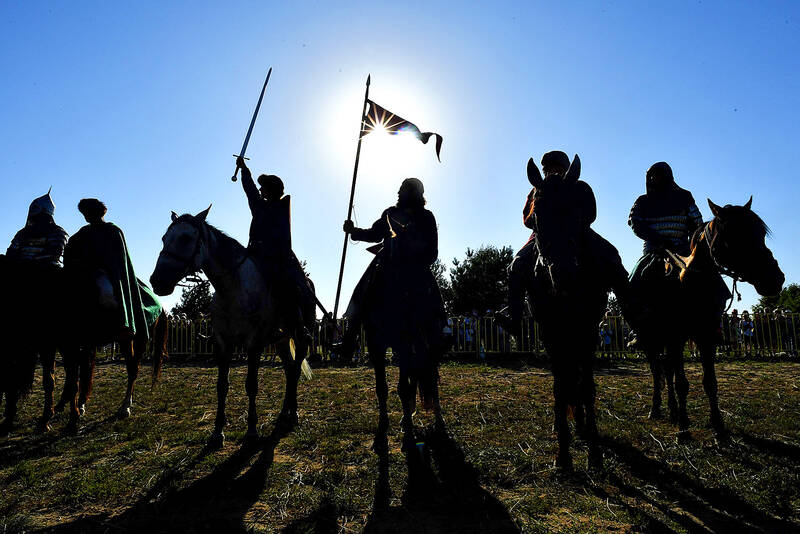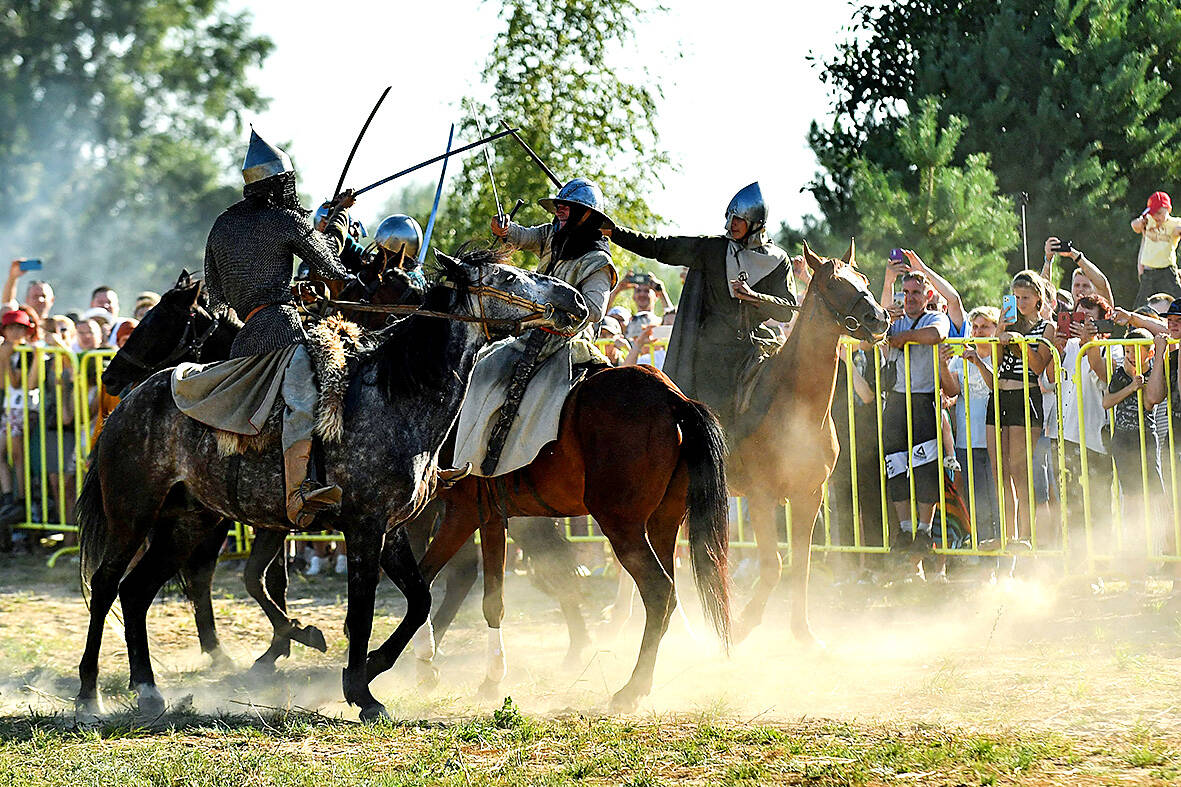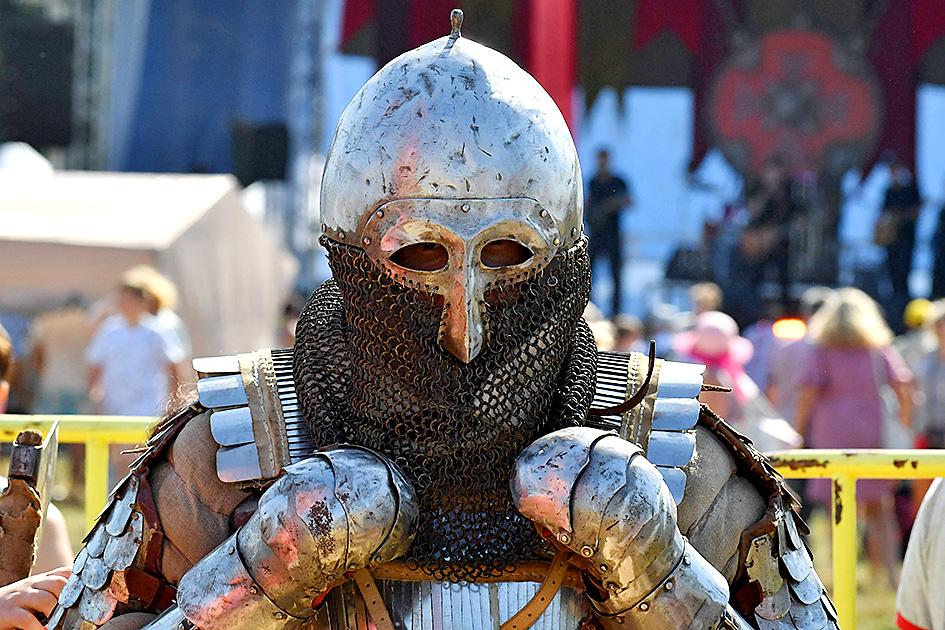Surrounded by dozens of men in chainmail and helmets playing dead in a field, an impersonator of medieval Russian prince Alexander Nevsky raises his sword and roars.
“This land is Russian, always has been, and always will be!”
It was on this spot near Lake Peipus on Russia’s border with Estonia that eight centuries ago Nevsky repelled a force of Teutonic Knights who wanted to convert Russia to Catholicism.

Photo: AFP
Known as the Battle of the Ice because it was fought largely on the frozen lake, the clash in April 1242 is celebrated as a great victory against efforts to turn Russia away from Eastern Orthodox Christianity.
For the hundreds of history enthusiasts re-enacting the battle on a recent August day, that victory is especially resonant today, as Russian forces wage an offensive in Ukraine framed by the Kremlin as part of an enduring conflict with the West.
“We are fighting against Europe just like our ancestors did,” says Oleg Yakontov, a 56-year-old retired paratrooper, holding a sword and shield as sweat drips off his face.

Photo: AFP
Historical re-enactments are a popular pastime in Russia, whether of medieval battles, Napoleonic-era clashes or the fierce fighting of World War II.
Drawing parallels with that history — and with President Vladimir Putin as a kind of successor to figures like Nevsky — is part of the messaging put forward by the Kremlin and Russian state media in support of Moscow’s campaign in Ukraine.
“To me, Nevsky symbolizes the defense of the Motherland and victory,” says 23-year-old Vladislav Vasilyev, still out of breath after taking part in the re-enactment.

Photo: AFP
Several hundred people gathered for the mock battle near the lake, called Lake Chud in Russian. They feasted on grilled meat and listened to live rock music as the combatants pummeled each other on the field.
The event culminated in horseback combat demonstrations a few meters away from a large metal sculpture of Nevsky that was inaugurated last September by Putin and Patriarch Kirill, the head of the Russian Orthodox Church.
“Alexander Nevsky’s personality was truly grandiose,” Putin said at the time, praising him as a “talented commander” and “skilful diplomat.”

Photos: AFP
Part of the modern-day appeal of Nevsky for the Kremlin was his alliance with the great power of the time, the Mongol Empire and its Golden Horde, which had destroyed and seized many of Russia’s lands. For some in Russia, Nevsky’s acceptance of Mongol dominion helped preserve the country’s religious traditions and Eurasian character in the face of Western expansionism.
“His main achievement is this civilizational choice,” says Igor Fomyn, a bearded 52-year-old Orthodox priest in a black cassock who came to watch the spectacle.
“By making this choice, he put spirituality, his people, and his Motherland before comfort,” he says.
Nevsky has been used in the past to stir up patriotic fervor, most famously in Sergei Eisenstein’s landmark propaganda film Alexander Nevsky in 1938.
Made at a time of strained ties between the Soviet Union and Nazi Germany, the film portrayed Nevsky as a heroic figure battling Teutonic domination. It features an epic recreation of the battle at Lake Peipus with the heavily armored crusaders crashing through the ice and drowning — a scene many historians regard as of dubious authenticity.
The film was pulled from cinemas when the USSR and Germany signed a non-aggression pact in 1939, then allowed back onto screens when the Nazis invaded the Soviet Union in 1941.
Nevsky remains a cherished historical figure for many in Russia, and some here have little doubt about who would be his modern counterpart.
“Our president is continuing his work, of course,” says Oleg Davydov, a 52-year-old engineer, in attendance at the re-enactment.
“It’s all about this country’s defense, its strength, its security.”

US President Donald Trump may have hoped for an impromptu talk with his old friend Kim Jong-un during a recent trip to Asia, but analysts say the increasingly emboldened North Korean despot had few good reasons to join the photo-op. Trump sent repeated overtures to Kim during his barnstorming tour of Asia, saying he was “100 percent” open to a meeting and even bucking decades of US policy by conceding that North Korea was “sort of a nuclear power.” But Pyongyang kept mum on the invitation, instead firing off missiles and sending its foreign minister to Russia and Belarus, with whom it

When Taiwan was battered by storms this summer, the only crumb of comfort I could take was knowing that some advice I’d drafted several weeks earlier had been correct. Regarding the Southern Cross-Island Highway (南橫公路), a spectacular high-elevation route connecting Taiwan’s southwest with the country’s southeast, I’d written: “The precarious existence of this road cannot be overstated; those hoping to drive or ride all the way across should have a backup plan.” As this article was going to press, the middle section of the highway, between Meishankou (梅山口) in Kaohsiung and Siangyang (向陽) in Taitung County, was still closed to outsiders

President William Lai (賴清德) has championed Taiwan as an “AI Island” — an artificial intelligence (AI) hub powering the global tech economy. But without major shifts in talent, funding and strategic direction, this vision risks becoming a static fortress: indispensable, yet immobile and vulnerable. It’s time to reframe Taiwan’s ambition. Time to move from a resource-rich AI island to an AI Armada. Why change metaphors? Because choosing the right metaphor shapes both understanding and strategy. The “AI Island” frames our national ambition as a static fortress that, while valuable, is still vulnerable and reactive. Shifting our metaphor to an “AI Armada”

The Chinese Communist Party (CCP) has a dystopian, radical and dangerous conception of itself. Few are aware of this very fundamental difference between how they view power and how the rest of the world does. Even those of us who have lived in China sometimes fall back into the trap of viewing it through the lens of the power relationships common throughout the rest of the world, instead of understanding the CCP as it conceives of itself. Broadly speaking, the concepts of the people, race, culture, civilization, nation, government and religion are separate, though often overlapping and intertwined. A government